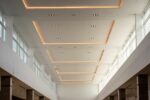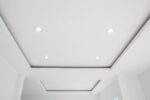This Post may contain Affiliate Links. Please read our Disclosure for legal jargon.
Are you thinking of building a new gutter or replacing the one you already have? Well then it’s about time you realise that gutters aren’t the only option you have!
The conventional style gutter system can be quite hard to maintain. The cons of it often outweigh the pros. So there’s no need to feel pressured to settle for the regular gutter. There are many other great alternatives to conventional gutter system that you might find more suitable!
Read on to get familiar with the various gutter alternatives that are more popular these days!
Outline
11 Gutter Alternatives That Work And Look Better
1. Underground Rain Chain
Rain chains are one of the most popular and efficient alternatives to the regular gutter system. There are broadly two kinds of rain chains – above ground or underground.
In the underground rain chain system, rainwater from the rooftop is collected via chains and led into a reservoir or basin below the ground. One of the biggest perks of the underground rain chain is that it has control over the forceful flow of water.
Available in a variety of distinct designs, this is one of the most opted for alternatives to the traditional gutter system.
Pros
- Attractive – It comes in many different styles and looks great.
- Control – It can reduce the speedy flow of water.
Cons
- Installation – Installing it can be quite tedious. There can be consequences if not installed properly.
- Limit – This system cannot manage a large amount of water.
2. Above Ground Rain Chain
This is the other type of rain chain system that is also quite the effective alternative. It is actually quite similar to the workings of an underground rain chain. The only difference being that the rainwater collected via chains is directed to a reservoir that is above the ground.
So the biggest advantage in the case of this type of rain chain is that you can conserve the collected water. This can be then used for many necessary purposes such as keeping the plants around your house hydrated.
Pros
- Conservation – Rainwater can be collected and used necessarily.
- Attractive – Can add on to the appeal of your house.
Cons
- Splashing – The rainwater might splash on to the building while channeled via chains.
- Ice – During extreme cold weathers, rain chains can freeze. The weight can damage your roof.
3. Rain Dispersal Systems
This system, as the name suggests, works by dispersing the rainwater into smaller streams or even into tiny droplets.
One of the main perks of the rain dispersal system is that it can control the flow of water. This helps in decreasing the impact of forceful rainwater flow. What’s more! It’s much easier to maintain and clean than the traditional gutter system!
Rain dispersal systems are designed with an efficient self clean mechanism that prevents issues like clogging. So it’s one less thing to worry about!
Pros
- Installation – It is quite easy and fast to install.
- Clean – It prevents clogging and trapping of debris, leaves, etc.
Cons
- Planning – There can be consequences if it is not laid out with proper and design planning.
4. Drip Path
This system mainly consists of paved pathways that are made from blocks or bricks. Since the surface of the pathways are basically quite hard, the rainwater that falls on it does not sink into the soil.
This prevents the soil erosion due to the forceful impact of the flowing rainwater from the roof.Besides, this surface is laid in such a way that the falling water does not splash onto the building.
The layout of the blocks/bricks ensure that the collected water is effectively drained out without affecting the foundation of the building.
Pros
- Cost – Setting up a drip path system is quite affordable.
- Maintanence – It is quite easy to maintain and causes minimal damage to the house.
Con
- Drainage – It is important to ensure the drainage capacity of the ground in order for the system to work efficiently.
5. Drip Edge
Drip edge is another possible alternative to the gutter system.In this system, a piece of metal is fixed to the edge of the roof.
In this way, the strip of metal functions as a sort of obstruction that brings down the force and impact of the fastly flowing water.
The mechanism of the system also allows the proper deflection of water away from the walls or foundation of the building. This prevents any sort of damage, staining or even the growth of mold.
Pros
- Shingles – Drip edge functions as a support system by not allowing water to get under the shingles and cause damage.
- Pests – This system prevents animals or any pests from entering the building/attic.
Cons
- Installation – It is not easy to install this system if the construction of the house/building is completed.
6. French Drain
Also known as ground gutters, this system is also a great alternative. The French Drain system mainly works through a connection of pipes that is laid out strategically around the house.
This requires a trench in order to ensure the proper directing of the rainwater from the roof to the underground drain. The trench should be built with a slope to prevent the collecting of water on the ground or near your house.
The biggest perk of the French Drain system is that it requires little to no maintenance. Just an yearly check of the drain outlet and you’re good to go!
Pros
- Appeal – This system does not hinder the aesthetics of the house as it is basically invisible from outside.
- Maintenance – Requires close to no maintenance at all.
Cons
- Installation – It is difficult to install this system besides the fact that it can be quite costly too.
7. Channel Drain
The channel drain system is also known by other names – trench drains or linear drains. As the name suggests, this system works through a network of long drains that direct the water away from the foundation of the house.
It is important that these drains are laid out strategically in keeping with the way water will flow. The drain channels are usually covered by means of trench grates which are available in a variety of styles and materials.
They last quite long and can be trusted with regard to efficacy. In this way, the system keeps the surroundings dry.
Pros
- Durable – The system if properly installed with trench grates, can be quite reliable and last a long time.
- Surroundings – The area can be kept dry using this system. The plants in the area can also be saved from getting flooded.
Cons
- Cost – Since the drains are quite long, large and heavy, the transportation cost can be expensive.
8. Copper Gutters
Copper gutters are quite similar to the regular gutters with regard to it’s mechanism and functioning. However the former has several more advantages than the latter.
One of the mains reasons behind the popularity of copper gutters is that they are in many ways much more appealing than the traditional gutters. While they look great and add on to the aesthetics of the house, this system requires only minimal maintenance efforts.
The gutter being made from copper adds on to the advantage since it is resistant to rust. This prevents it from getting corroded.
Pros
- Durable – Copper Gutters are quite reliable with their great strength, durability and rust-proof quality.
- Maintenance – This system calls for low maintenance.
- Eco-friendly – No negative impact on the environment.
Cons
- Cost – Copper along with all the materials necessary for installation, makes this system quite expensive.
9. Box Gutters
Box gutters are also known by other names such as – hidden gutter, built-in gutters. As the name so obviously suggests, this system is quite subtle in the sense that it doesn’t garner attention or affect the aesthetics of the building.
It works through a mechanism involving valley-like troughs at the roof edges, that channel the water safely away from the foundation.
Box gutters are a great alternative to the regular gutters because it is quite easy to maintain. Besides, this system also prevents problem like clogging.
Pros
- Appearance – It is to a great extent invisible from outside hence does not affect the aesthetics or appearance of the building.
- Clogging – This system rarely causes issues such as clogging.
Cons
- Cost – It can be quite expensive to install this system in the proper manner while also making it less visible.
- Corrosion – In the occasion of a rare case of corrosion or blockade, they can easily go unnoticed and hence damage the entire system.
10. Grading
This is a particularly great alternative if the construction of the building is incomplete and still in process. By effectively grading the ground, the house is built on a more elevated level than normal.
The slope thus made can quite naturally allow water to drain away from the foundation of the building or house. This way, grading system also prevents water from getting collected in the surroundings or ground near the foundation.
It is however important to ensure that the slope itself is quite smooth and doesn’t leave space for water to accumulate and stagnate.
Pros
- Natural – This system works quite naturally and effectively.
- Gutters – It does not call for the need of a gutter system at all.
Cons
- Cost – This system can be quite expensive in the case of houses that have completed construction.
- Low spots – If the slope does not have a smooth finishing, it can cause water to accumulate in low spots causing further issues.
11. Louver System
The Louver system can be described as a quite practical alternative to the traditional gutter system. Besides, its efficacy has also been proven to be trustworthy.
This system functions by a mechanism of rainwater dispersal. The unique self clean design of the Louver system allows for the prevention of clogging or even the collection of debris such as leaves.
What’s better! This mechanism even saves the ground from getting eroded due to the forceful impact of flowing rainwater. The Louver system does not affect the architectural beauty or aesthetics of the building either.
Pros
- Maintenance – It calls for low maintenance efforts owing to its self cleanimg mechanism.
- Appeal – The system does is invisible to a great extent and doesn’t have an impact on the appearance of the building/house.
Cons
- Wind – In cases of areas where rain is accompanied by wind, there is a high probability of the water splashing, dripping and creating a mess on the walls, doors, etc.
It’s of course a given fact that all these gutter alternatives have their own pros and cons. What’s important is to know that gutters aren’t the only option out there. It’s more about finding what’s more suitable for your house and its maintenance.
So take a moment to think before hastily deciding on traditional gutters. Because some of the alternatives given above may be a wiser choice!


